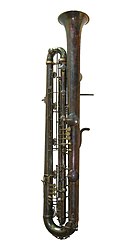Engineering:Contrabass sarrusophone
 Contrabass sarrusophone in E♭ | |
| Woodwind instrument | |
|---|---|
| Classification |
|
| Hornbostel–Sachs classification | 422.112 (Double reed aerophone with keys) |
| Inventor(s) |
|
| Developed | Mid 19th century |
| Playing range | |
<score lang="lilypond">
{
\new Staff \with { \remove "Time_signature_engraver" }
\clef treble \key c \major ^ \markup "written" \cadenzaOn
bes1 \glissando g1
\clef bass
\ottava #-1 des,,1 ^ \markup "E♭" \glissando \ottava #0 bes1
\ottava #-1 aes,,,1 ^ \markup "B♭" \glissando \ottava #0 f1
}
</score><score lang="lilypond">
{
\new Staff \with { \remove "Time_signature_engraver" }
\clef bass \key c \major \cadenzaOn
bes,,1 ^ \markup "C written" \glissando g'1
\ottava #-1 bes,,,1 ^ \markup "sounds" \glissando \ottava #0 g1
}
</score> | |
| Related instruments | |
| Builders | |
Historical:
| |
| More articles or information | |
Sarrusophones:
| |
The contrabass sarrusophone is the deepest of the family of sarrusophones, built in three sizes pitched in E♭, C or B♭. It was made in the 19th and early 20th centuries, primarily in France by its inventor and Parisian instrument maker Pierre-Louis Gautrot (fr) and his successor PGM Couesnon (fr), and Evette & Schaeffer. It was also made in Italy by Milan manufacturers Romeo Orsi and Rampone & Cazzani, and in the United States by C. G. Conn, who built instruments in E♭ for US military bands.[1] Romeo Orsi and the German instrument maker Benedikt Eppelsheim make individual contrabass sarrusophones on request.[2][3]
Tone
The EE♭ sarrusophone has the tone of a reedy contrabass saxophone, while the CC sarrusophone sounds much like the contrabassoon. The BB♭ contrabass sarrusophone is the lowest of the sarrusophones, and was the lowest-pitched wind instrument until the invention of the EEE♭ octocontra-alto and the BBB♭ octocontrabass clarinets, and the BB♭ subcontrabass tubax. Contrabass sarrusophones come in two bore widths: big pipes, which sound mellower and softer, but are still reedy; and small pipes, which are extremely reedy.[4]
The EE♭ and BB♭ sarrusophones are transposing instruments.
The contrabass sarrusophone is sometimes confused with the reed contrabass, to which it bears a superficial resemblance.
Reed
Contrabass sarrusophones take rather large reeds; they are larger than contrabassoon reeds. This leads to most people making their own reeds (as is the practice of most oboe and bassoon players). Contrabass sarrusophone reeds are still manufactured by Vandoren. Sarrusophones are traditionally played with a double reed, but single reed mouthpieces have also been used. These mouthpieces are similar in size to soprano or alto saxophone mouthpieces.
Size
Contrabass sarrusophones are comparatively light for contrabass instruments, weighing only about as much as a baritone saxophone, and being approximately four feet tall, about the same height as a bass saxophone. This makes them more convenient to hold, play and transport.
Use
Classical
The sarrusophone is rarely scored in classical music today, but there are a few examples. Pieces written for it include Percy Grainger's Over the Hills and Far Away, Paderewski's Symphony in B Minor (Polonia), which called for three EE♭ contrabass sarrusophone players, Maurice Ravel's Rapsodie Espagnole, Sheherazade and L`heure espagnole, and Arrigo Boito's Nerone. Paul Dukas also used it in his orchestral tone poem The Sorcerer's Apprentice. Claude Debussy includes the CC instrument in Jeux, as does Frederick Delius in Eventyr, Requiem and Songs of Sunset. Jules Massenet writes for it in Esclarmonde. The instrument is given notable solos in Arnold Bax's First Symphony, written in 1921–22. Igor Stravinsky's first fully serial work, Threni (1958), a symphonic/choral setting of passages from the Latin Vulgate of the Book of Lamentations, includes a sarrusophone in its unusual scoring, which also features a solo Flugelhorn. American composer Barney Childs composed a chamber work, The Golden Bubble (1967), for EE♭ contrabass sarrusophone and one percussionist. Kaikhosru Shapurji Sorabji frequently utilized the contrabass sarrusophone, calling for it in his 1st, 4th, and 8th piano concertos, Opus clavisymphonicum for piano and orchestra, his two orchestral symphonies and the Messa grande sinfonica.[5]
Jazz
The song "Mandy Make Up Your Mind" recorded in 1924 with Clarence Williams and Louis Armstrong features an extended solo by Sidney Bechet on EEb Contrabass Sarrussophone and continues to feature him for approximately the last half of the song.[6] On Frank Kimbrough’s 2018 album Monk's Dreams: The Complete Compositions of Thelonious Sphere Monk Scott Robinson plays contrabass sarrusophone on the tracks “Misterioso” and “Straight No Chaser”.[7]
References
- ↑ 1.0 1.1 "Sarrusophone". Grove Music Online (8th ed.). Oxford University Press. 2001. doi:10.1093/gmo/9781561592630.article.24597.
- ↑ "Instruments Made on Request". Romeo Orsi. http://www.orsi-wind-instruments.it/surichiesta.htm.
- ↑ "Custom Made". Benedikt Eppelsheim Wind Instruments. https://www.eppelsheim.com/en/instruments/custom/.
- ↑ "Sarrusophones". Contrabass Mania. http://www.contrabass.com/pages/sarrus.html. Retrieved 2009-02-11.
- ↑ "Sorabji Resource Site: Orchestral Forces". https://roberge.mus.ulaval.ca/srs/05-orche.htm.
- ↑ Chilton, John (1996). Sidney Bechet: The Wizard of Jazz. New York: Da Capo Press. p. 66. ISBN 0-306-80678-9.
- ↑ Sullivan, Mark (December 12, 2018). "Frank Kimbrough: Monk's Dreams: The Complete Compositions Of Thelonious Sphere Monk". https://www.allaboutjazz.com/monks-dreams-the-complete-compositions-of-thelonious-sphere-monk-frank-kimbrough-sunnyside-records-review-by-mark-sullivan.php.
External links
- Green, Grant D. Sarrusophones. Contrabass Compendium (archived)
 |

